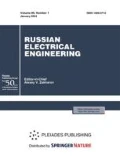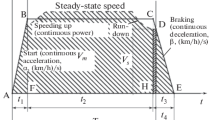Abstract
This article deals with an algorithm for generating a set of acceptable values of energy supply indicators. This algorithm has been designed for use in intelligent systems to make decisions on the carrying of heavy trains on limiting sections. Using the generated sets of permissible parameters of operational indicators for weight, speed, and location of oncoming and passing trains will allow sending trains according to energy-efficient train paths. The algorithm contains sections of energy supply and cargo turnover, assessment of the acceptable parameters of electricity supply, and obtaining a set of acceptable parameters of operational parameters of train accommodation.
Similar content being viewed by others
A number of Russian Railways polygons produce and use energy-optimal schedules for passing trains in order to save electric energy. It was proposed at Samara State Transport University to use an intelligent complex for managing energy-efficient train passes according to the conditions of power supply (IC ETP-PS) in order to implement operational energy-optimal modes for passing trains.
The goal was to develop an algorithm for generating acceptable values of power supply for heavy trains in design sections that will allow making operational decisions on the basis of intelligent control systems when passing heavy trains.
The absolute power consumption for traction W can be represented as a functional in the following form: W = F(A, MFR, Vsec, Jsp, Jon, e), where A is the train operation, MFR is the mass of freight trains, Vsec is the speed on the section, Jsp is the train spacing, Jon is the time intervals of oncoming trains, and e are stochastic factors that affect the spread of power consumption values W [1, 2]. In this case, all W values are divided into acceptable and unacceptable subsets according to the criteria of the load capacity of the traction power system: P is the power of the power equipment of the traction substations, U is the minimal voltage on the current collectors of electric locomotives, and Ics and Irtn are the allowable current in the contact system and the current in the reverse traction network, respectively. An algorithm for generating subsets of the acceptable energy supply values for intelligent systems for passing heavy trains with a reduced amount of calculations, including three stages, is presented in Fig. 1.
Stage 1. Identification and assessment of the adequacy of electricity consumption on the calculation section (operators 1–15). This stage includes procedures for monitoring and generating initial data and evaluating the adequacy of the indicator “Power consumption for traction” under the conditions of analyzing the dynamics of cargo traffic or 1-t km work in electric traction. The main procedures of the first stage include the generation of databases, identification of the parameters of the power consumption model W*, and construction of a model implementation of W*(t) with a mean absolute percentage error (MAPE) assessment. The MAPE estimation cannot be more than 4% when predicting W*(t) [2, 3].
Stage 2. Simulation and assessment of energy supply (operators 16–33). This stage includes the procedures for assessing the load capacity of the traction power system on the calculated section when comparing them with the predicted values of the indicator “Traction power consumption,” generation of a database of traction power system elements for the calculated section using the CORTES or ARES application software packages [4], and establishing cycles according to indicator of intertrain intervals Jfr, mass of heavy freight trains Mfr, and technical speed of freight trains Vtec. The results of the simulation of power consumption of the calculated section (Penza–Syzran) are presented in Fig. 2.
Calculation results: (a) graphs of the indicator of the load capacity of the traction power supply system according to the voltage level in the contact system and the energy consumption at the traction substations and (b) indicators of the dynamics of the voltage at the current collector of electrically propelled vehicles weighing 6300, 7700, and 9000 t when the speed is changed.
In operators 31–33, the calculation results are interpolated according to the criteria for the load capacity of the traction power system (PTPS, U, Ics, \(T_{{{\text{cs}}}}^{{\text{0}}}\), I0). The energy supply boundaries are generated as the functions \(V_{{{\text{tec}}{\text{.fr}}}}^{{\text{E}}}\) = F(Mfr, Jfr), \(M_{{{\text{fr}}}}^{{\text{E}}}\) = F(Vtec.fr, Jfr), and \(J_{{{\text{fr}}}}^{{\text{E}}}\) = F(Mfr, Vtec.fr). Figure 3 shows an example of identifying the boundaries of the permissible values for the mass of the train and the technical speed at fixed intertrain intervals Jsp and Jon equal to 10 min. Figure 3b presents an interpolation histogram and a statistical expression of the boundary of the permissible (maximum) speed of passing heavy trains weighing 6300–9000 t. The histogram allows determining the maximum permissible technical speed of passing trains on the calculated section. Thus, a train weighing 7100 t can be passed at a speed of no more than 90 km/h and one weighing 9000 t can be passed at a speed of no more than 52.5 km/h.
Stage 3. The stage includes the procedures for implementing measures that either improve the energy supply indicators of the section by “strengthening” the elements of the traction power system or select acceptable modes for passing heavy trains [5]. After strengthening the traction power system, the energy supply can be improved by adjusting the schedule by selecting a group of parameters, e.g., with an extended intertrain interval from a set of previously obtained interrelated values of Jfr, Mfr, and Vtec.fr.
CONCLUSIONS
(1) A distinctive feature of the proposed algorithm is the reduction of the computational simulation procedures and obtaining results by interpolating extreme values of operational indicators, these being the train mass, speed on the section, and intertrain interval.
(2) The acceptable values of operational indicators obtained can be used for operational decision-making when passing heavy trains using intelligent control systems.
REFERENCES
Kopeikin, S.V. and Mitrofanov, A.N., Optimal management of railway development indicators and energy supply of trains, Izv. Samar. Nauchn. Tsentra, Ross. Akad. Nauk, 2005, no. 2005, special issue.
Mitrofanov, A.N., Dobrynin, E.V., Tret’yakov, G.M., et al., Identification and control of indicators of the transportation process based on multifactor models, Vestn. Transp. Povolzh., 2016, no. 6 (60).
Zheleznov, D.V., Mitrofanov, A.N., and Mitrofanova, N.V., Principles of identification and forecasting, Zheleznodor. Transp., 2017, no. 3.
Mitrofanov, A.N., Garanin, M.A., and Dobrynin, E.V., RF Inventor’s Certificate no. 2005611049, 2005.
Mitrofanov, A.N., Garanin, M.A., Dobrynin, E.V., and Krestovnikov, I.A., Usilenie sistemy tyagovogo elektrosnabzheniya pri provedenii poezdov povyshennoi massy i dliny (Improvement of the Traction System of Power Supply of Trains with Higher Mass and Length), Samara, 2006.
Author information
Authors and Affiliations
Corresponding author
Additional information
Translated by N. Petrov
About this article
Cite this article
Mitrofanov, A.N., Dobrynin, E.V. & Mitrofanov, S.A. An Algorithm for Generating Sets of Acceptable Energy Supply Values for Intelligent Systems for Carrying Heavy Trains. Russ. Electr. Engin. 91, 186–190 (2020). https://doi.org/10.3103/S1068371220030128
Received:
Revised:
Accepted:
Published:
Issue Date:
DOI: https://doi.org/10.3103/S1068371220030128







